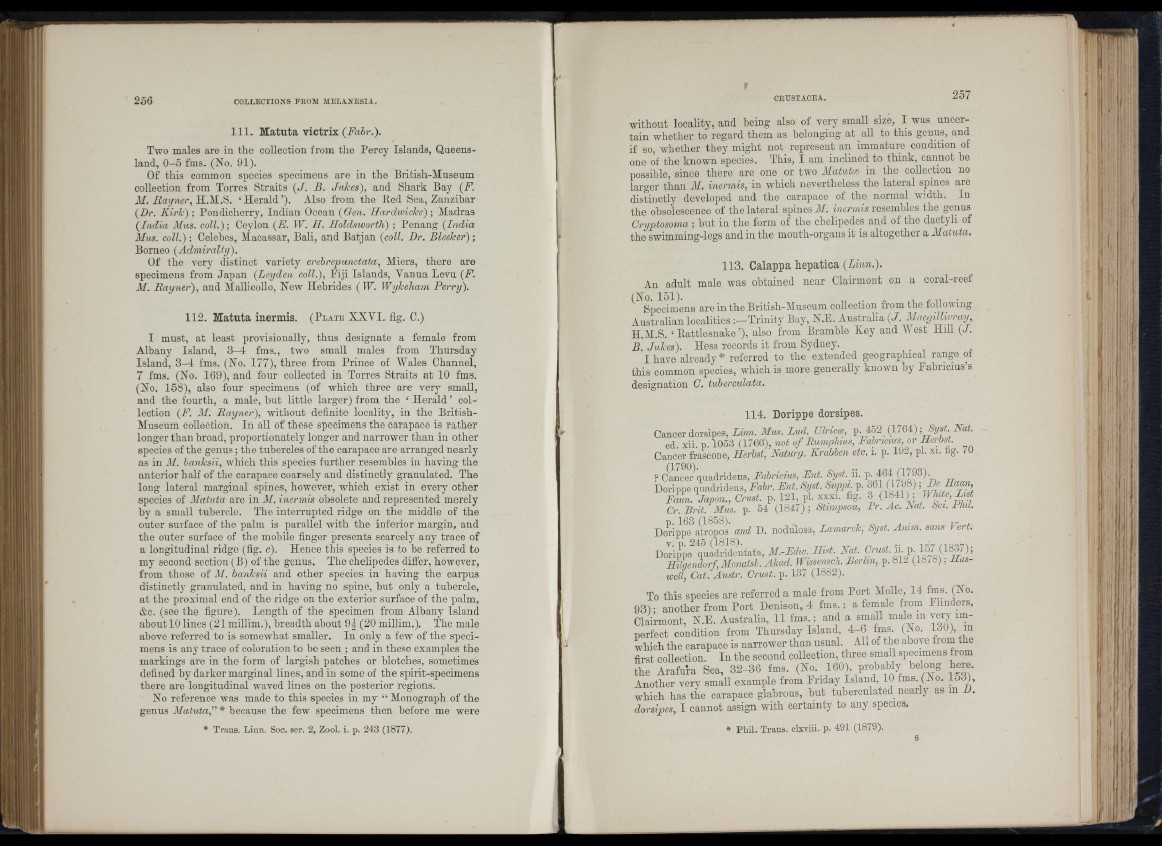
111. Matuta victrix (Fabr.).
Two males are in the collection from the Percy Islands, Queensland,
0 -5 fms. (No. 91).
Of this common species specimens are in the British-Aluseum
collection from Torres Straits (J. B. Jakes), and Shark Bay (F.
M. Bayner, H.Al.S. ‘H e ra ld ’). Also from the Red Sea, Zanzibar
(Dr. K irk ); Pondicherry, Indian Ocean (Gen. Hardivicke) ; Aladras
(India AIus. coll.) ; Ceylon (B. W. II. Holdsworth) ; Penang (India
AIus. coll.); Celebes, Alacassar, Bali, and Batjan (coll. Dr. Bleeker);
Borneo (Admiralty).
Of the very distinct variety crehrepunctata, Aliers, there are
specimens from Japan (Leyden coll.), Fiji Islands, Vanua Levu (F.
AI. Bayner), and AlallicoILo, New Hebrides (IF. Wykeham Perry).
112. Matuta iuermis. ( P l a t e XXVI. fig. C.)
I must, at least provisionally, thus designate a female from
Albany Island, 3 -4 fms., two small males from Thursday
Island, 3 -4 fms. (No. 177), three from Prince of Wales Channel,
7 fms. (No. 169), and four collected in Torres Straits a t 10 fms.
(No. 158), also four specimens (of whieh three are very small,
and the fourth, a male, but little larger) from the ‘ Herald ’ collection
(F. AI. Bayner), without definite locality, in the British-
Aluseum collection. In all of these specimens the carapace is rather
longer than broad, proportionately longer and narrower than in other
species of the genus ; the tubercles of the carapace are arranged nearly
as in Al. hanksii, which this species further resembles in having the
anterior half of the carapace coarsely and distinctly granulated. The
long lateral marginal spines, however, which exist in every other
species of Alatiita are in AI. inermis obsolete and represented merely
by a small tubercle. The interrupted ridge on the middle of the
outer surface of the palm is parallel with the inferior margin, and
the outer surface of the mobile finger presents scarcely any trace of
a longitudinal ridge (fig. c). Hence this species is to be referred to
my second section (B) of the genus. The chelipedes differ, however,
from those of AI. banksii and other species in having the carpus
distinctly granulated, and in having no spine, but only a tubercle,
at the proximal end of the ridge on the exterior surface of the palm,
&c. (see the figure). Length of the specimen from Albany Island
about 10 lines (21 millim.), breadth about (20 millim.). The male
above referred to is somewhat smaller. In only a few of the specimens
is any trace of coloration to be seen ; and in these examples the
markings are in the form of largish patches or blotches, sometimes
defined by darker marginal lines, and in some of the spirit-specimens
there are longitudinal waved lines on the posterior regions.
No reference was made to this species in my “ Alonograph of the
genus Alatuta,” * because the few specimens then before me were
*■ Trans. Linn. Soc. ser. 2, Zool. i. p. 243 (1877).
without locality, and being also of very small size, I was uncertain
whether to regard them as belonging at all to this genus, and
if so, whether they might not represent an immature condition of
one of the known species. This, I am inclined to think, cannot be
possible, since there are one or two AJatutce in the collection no
larger than AI. inermis, in which nevertheless the lateral spines are
distinctly developed and the carapace of the normal width. In
the obsolescence of the lateral spines ilf. inermis resembles the genus
Oryptosoma; but in the form of tlie chelipedes and of the dactyli of
the swimming-legs and in the mouth-organs it is altogether a Aiatuta.
113. Calappa hepática (Linn.).
male was ohtained near Clairmont An adult on a coral-reef
Spec'im^ens are in the British-AInseum collection from the following
Australian localities ;-T r in ity Bay, N.E. Australia {J-MacgilUxrcnj
H.Al.S. ‘ Rattlesnake’), also from Bramble Key and AVest Hill ( J .
B Jukes). Hess records it from Sydney.
I have already * referred to the extended geographical range ot
this common species, which is more generaUy known by Fabncius’s
designation G. tuberculata.
114. Dorippe dorsipes.
Cancer dorsipes, imw. AIus. Lud. Ulrica}, p. 452 (1764) ; Ar/V. Aai.
ed. xii. p. 1053 (1766), not o f Bumphius, Fabricius or Herbst.
Cancer frascone, Herbst, Naturg. Krabben etc. i. p. 192, pi. xi. fag. 7U
? Cauce?quadvidens, Fabricius, Ent. Syst. A. P - „
Dorippe quadridens, Fabr. E n t. Syst. Supjil p. 361 (1 /J8) ; B e Haan,
F h L . Japon., Crust, p. 121, pi. xxxi. fig. 3 (1841) ; FMp ,
Cr. B rit. AIus. p. 54 (1847); Stimpson, Fr. Ac. Nat. Sci. Phil.
Dorippe ariopos and D. nodulosa, Lamarck, Syst. Am m . sans Vert.
Dori|pe quadridentata, AI.-Fdw^ Hist. Nat.
HilqendorfAIonatsh. Akad. Wissenscn. Berlin, p. 812 (18/8), Haswell,
Cat. Austr. Crust, p. 137 (1882).
To this species are referred a male from Port Alolle, 14 fms. (No.
93) • another from Port Denison, 4 fm s .; a female from Flinders,
Clairmont, N.E. Australia, 11 fms ; and a small male in very imperfect
condition from Thursday Island 4 -6 fms (No. I'^O)^ “
which the carapace i s narrower than usual. AU of the above fi om the
first coUection. In the second coUection, three small specimens from
th e'A ra fu ra Sea, 32-36 fms. 160), prohably helc^g here.
Another very small example from Eriday Island, 10 fms. (No. 153),
which has the carapace glabrous, but tuberculated nearly as in .
dorsipes, I cannot assign with certainty to any species,.
* Phil. Trans, clxviii. p. 491 (1879).
3 . 1
M h ! .
t
I Hit ! I
I w ; I
f l '
I